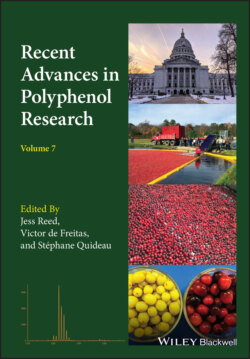Читать книгу Recent Advances in Polyphenol Research - Группа авторов - Страница 11
Оглавление
Preface
Every two years, Groupe Polyphénols (GP) hosts the International Conference on Polyphenols (ICP). The XXIX ICP was the first one to be held in the United States in Madison, Wisconsin, on the campus of the University of Wisconsin–Madison (UW–Madison), from July 16 to 20, 2018. Groupe Polyphénols also hosted the 9th Tannin Conference (TC) concurrently with the XXIX ICP. Groupe Polyphénols was founded in 1972 and is the world’s premier society of scientists in the fields of polyphenol chemistry, synthesis, bioactivity, nutrition, industrial applications, and ecology.
Madison is Wisconsin’s state capital (the capitol building is shown on the front cover) and one of the nicest cities in the great lakes region. UW–Madison is a top ranked University (25th worldwide and 19th in the USA) and has a lovely campus with miles of lakefront and beautiful scenery adjacent to the state capitol. This venue for the XXIX ICP and 9th TC was fitting because Wisconsin’s cranberry industry provides 60 percent of the world’s supply of cranberries and is the state’s largest fruit industry. The cranberry industry is also strongly dependent on the polyphenolic composition of the fruit. Cranberries are harvested in the fall after they turn from yellow‐green to bright red, as shown on the front cover. The fruits are harvested by flooding the marsh (also called cranberry bogs). After removing the fruits from the vine, they float to the surface and are corralled with a floating boom and conveyed into trucks (as depicted on the front cover). The fruits are either transferred to a packaging facility for the fresh fruit market or to a frozen storage facility for subsequent processing into juice or sweetened dried cranberries (SDC). In both cases the bright red color of the fruit is a critical component of processing because the fruit is sorted based on color before packaging as fresh fruit or processing for juice and SDC (a processing line after sorting is also shown on the front cover). The color is a function of six anthocyanins, cyanidin 3‐O‐galactoside, cyanidin 3‐O‐glucoside, cyanidin 3‐O‐arabinoside, peonidin 3‐O‐galactoside, peonidin 3‐O‐glucoside, and peonidin 3‐O‐arabinoside. In addition to the anthocyanins, cranberries contain a large diversity of other monomeric polyphenols, especially flavonol glycosides, and contain simple phenols such as hydroxycinnamic acids and hydroxybenzoic acids. Cranberries also contain proanthocyanidins, which are just as important to the economic value of the fruit as the anthocyanins. The importance of proanthocyanidins to the cranberry market is a result of pioneering research from the late 1990s in which “A‐type” interflavan bonds were discovered to be the structural feature of cranberry proanthocyanidins that is associated with the prevention of adherence of P‐fimbriated E. coli to uroepithelial cells, the putative mechanism in the prevention of urinary tract infections. Proanthocyanidin content is now used to market cranberry products (including juice, sweetened dried cranberries, and dietary supplements) and consumers widely recognize cranberries as healthy. Therefore, all of the subjects that were discussed at the XXIX ICP and 9th TC and the chapters of this volume of Recent Advances in Polyphenol Research are of direct importance to Wisconsin’s cranberry industry. The role of polyphenols in this industry is an excellent example of the importance of polyphenol research in general.
The XXIX ICP and 9th TC were attended by 189 registrants from 23 countries, with 62 invited and contributed presentations and 104 posters. This seventh edition of Recent Advances in Polyphenol Research presents 11 chapters that represent the work of the invited speakers at the XXIX ICP and 9th TC and reflect the depth of science in this important field of natural product chemistry. The conference included sessions on the chemistry and physical chemistry of polyphenols; synthesis, genetics and metabolic engineering of polyphenols; the effects of polyphenols on the nutrition and health of humans and animals; the role of polyphenols in plants and ecosystems; applied research on polyphenols; and a special session devoted to the 9th Tannin Conference.
We owe a special thanks to Hannah Scott and Laura Richards from the Campus Events Services, UW–Madison, for their professional and excellent organization of the conference. Finally, we thank all of the participants, some who traveled a great distance to come to Madison, for making the conference a very enjoyable event and a wonderful learning experience.
Jess Dreher ReedVictor Armando Pereira de FreitasStéphane Quideau
